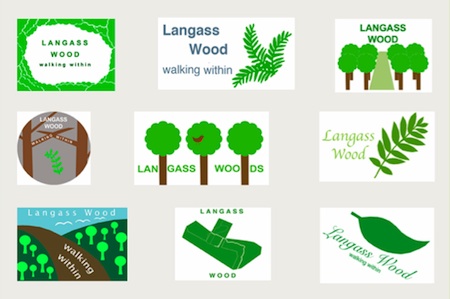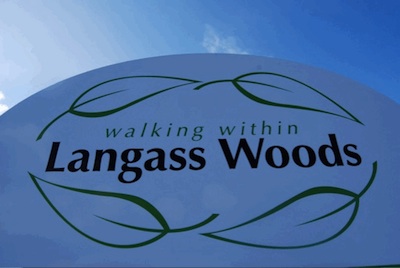
ABOUT
This interdisciplinary project aimed to creatively interpret the ecology and heritage of Langass Woods on North Uist, combining outdoor learning and the arts with social subjects, sciences, languages and new technologies. Taigh Chearsabhagh Museum and Arts Centre worked collaboratively with S2 pupils and staff from Sgoil Lionacleit (Benbecula), Carinish and Lochmaddy Primary Schools, Urras nan Craobh Uibhist a Tuath (North Uist Woodland Trust), and Scottish Natural Heritage.
S2 pupils worked with artist and publisher Alec Finlay, poet Colin Wills and other partners to create a letterbox walk for the woodland and an accompanying digital guide on handheld mobile devices. Through the project, children and young people were encouraged to make a valuable contribution to the care and future of their own natural environment. Learning outputs from the project have been shared nationally through the project Glow Group.
Click here to watch 5 minute video

The project involved:
• Taigh Chearsabhagh Museum and Arts Centre
• P1-7 pupils from Carinish Primary school
• S2 pupils from Lionacleit Secondary school
Partners:
• Scottish Natural Heritage
• North Uist Woodland Trust
• Wild Knowledge (outdoor education specialists)
• Hebridean Graphics
• Freelance artists
• Comhairle nan Eilean Siar local authority

PURPOSE
The project aimed to creatively interpret the ecology and heritage of Langass Woods on North Uist, combining outdoor learning and the arts with social subjects, sciences, languages and new technologies, creating both a physical and virtual guide to the woodland.
CURRICULUM AREAS
• Expressive Arts
• Languages
• Sciences
• Social Studies
• Technologies
LEVELS AND STAGES
P1 – S2
TYPES OF LEARNING
The project was inter-disciplinary – extending to Languages, Science, Numeracy, English, Art, Music and ICT. Creative, active and group approaches to learning were important as was outdoor learning.



PROJECT ACTIVITY
S2 pupils from Sgoil Lionacleit, and P1-7 pupils from Carinish primary school, worked with artist and publisher Alec Finlay, musician Rhodri Davis, poet and naturalist Colin Will, and poet Ken Cockburn to create a ‘Letterbox trail’ and a ‘word map’ for the woodland, with an accompanying digital guide for handheld mobile devices.
Workshops, activities and field trips to the woodland, led by the artists, and/or Taigh Chearsabhagh staff, teachers, and staff from Scottish Natural Heritage/Hebridean Graphics/Wild Knowledge, included:
• ecology walk with Scottish Natural Heritage;
• nature ramble, tree planting, creative mapping, sculpture work, and creative writing, including Haiku and Mesostic poems;
• development of letter box trail and walkway guide;
• composing music;
• development of a digital guide to Langass Woods using digital handheld devices with GPS, and creating a website;
• making signage for the woodland trail;
• logo design workshops with Hebridean Graphics.

Partnership working was a key element of this project. North Uist Woodland Trust and Scottish Natural Heritage (South Uist) spent time with pupils talking about the history and ecology of the woodland and helping with the pupils’ research, identification and interpretation of local species of plants, trees and birds. This work was used to inform interpretation boards made by the pupils, and to provide content for the digital guide. Graphic designer Lorraine Burke ran a workshop on logo design, and the resulting designs by S2 pupils were uploaded to the project Glow Group.
Outdoor education specialists, Wild Knowledge, developed a digital guide to accompany the woodland trail which is populated by pupils’ photographs, poems, sound recordings and research, giving visitors an even richer experience of this community owned woodland.

How was Glow used?
Glow was used to document the project and to create a resource for other schools/pupils wishing to visit the woodland or learn more about its ecology. The content was created by pupils in collaboration with the project partners. The primary school Headteacher and staff at Taigh Chearsabhagh felt that Glow had helped to bring the project to life, allowing pupils to be actively involved in contributing to the project by sharing materials and learning online.

IMPACTS
An independent evaluation was carried out by Blake Stevenson. Their research shows that the project had the following impacts:
New skills, knowledge and approaches for teachers
The project involved extensive work in an outdoor environment, which staff at Taigh Chearsabhagh felt was a new learning environment for the pupils involved. There was also a real emphasis on using digital technology, particularly to create a ‘digital trail’ of Langass Wood using handheld digital devices which used GPS to map the location of items that young people wanted to include in the trail.
The Headteacher from the primary school suggested that the involvement of the artists had definitely resulted in a more creative teaching experience, enriching the learning experience of pupils. The project had:
• helped them thinking about delivering teaching in a more creative way;
• encouraged them to do more/think differently;
• encouraged them to plan more collaborative work in future (the primary school are looking into working with another primary school on a new project).
The principle teacher of Art and Design at the secondary school enthused about having worked in collaboration with the English department on illustrated Haiku.

New skills, knowledge and experiences for pupils
Following the project, S2 pupils met after school to continue working on their contribution to the digital guides. Carinish primary pupils loved using the mobile devices, and particularly enjoyed writing mesostic poems with Alec Finlay.
The project promoted the following key learning:
• knowledge of nature and the natural environment;
• an appreciation of the local environment;
• use of digital technology and Glow;
• creating innovative art work;
• skills in and knowledge of poetry, music, art and design;
• independence ad increased confidence
• experience of working with arts professionals

The project supported pupils to achieve progress in the following ways:
• Successful Learners – during the work of the project pupils were enthusiastic and motivated learners and became open to new thinking and ideas. Pupils were supported to improve their literacy, communication and numeracy, thinking creatively and independently, linking and applying different kinds of learning in new situations, learning independently and as a group and use technology for learning.
• Responsible Citizens – as a result of the project pupils were supported to become more respectful of others and to participate responsibly in cultural life. Pupils were supported to develop greater understanding and knowledge of the world and Scotland’s place in it, evaluate environmental, scientific and technological issues, and develop informed and ethical views of complex issues.
• Confident Individuals – the project increased pupils’ self-respect and helped them to have more secure values and beliefs and a sense of physical, mental and emotional well-being. Pupils became better able to relate to others and manage themselves, pursue a healthy and active lifestyle, be self-aware and develop and communicate their own beliefs and view of the world.
• Effective Contributors – the project supported pupils to work in partnership and in teams, to take the initiative and lead, communicate in different ways and in different settings, apply critical thinking in new context, solve problems, and create and develop.

New skills and knowledge for Taigh Chearsabhagh
The project gave Taigh Chearsabhagh more experience of working with pupils and teachers in schools, particularly working in a secondary school. They were able to learn more about working with young people, what to offer them and how. They also developed their understanding of CfE. This has helped them to develop their practice in this area, and encourage them to think about doing this more in future.
Taigh Chearsabhagh has developed a new relationship with the secondary school they worked with. The Project has has also strengthened links between Taigh Chearsabhagh/the schools and the North Uist Woodlands Trust, and Scottish Natural Heritage.
CHALLENGES AND LEARNING
Taigh Chearsabhagh commented that the initial challenge was combining the use of digital technology with art and education to engage with local Woodland, as this was the first time they had undertaken a project combining these elements. The arts organisation staff were satisfied that they had managed to overcome this challenge.
There were some technical issues that were frustrating at times, particularly with the use of Glow, however these were overcome with support from LTS.
Another challenge was that the secondary school lost 11 members of staff over the summer holidays, before the project got started properly the following term. This meant staff at the school were required to fill in for teachers who had left, and they had very limited time to work on the project. It also made communication with the secondary school difficult, as staff were often unavailable for consultation.
The project would have been better if there had been more time for planning and prep work on behalf of the teachers, but also in conjunction with Taigh Chearsabhagh. On top of this, teachers perhaps did not realise the time/planning that would be involved in the project.
It would also have been beneficial to allow more time for the project in the curriculum, rather than fitting it in around time-tabled lessons ad hoc. This issue is linked to the limited planning that happened – more planning may have enabled this to happen. Teachers would have liked to have had more time for follow-up activities in class. It was also felt that the project may have been easier if it had not occurred when the secondary school was in the process of establishing CfE.
Schools were not using Glow much in the classroom, so Taigh Chearsabhagh staff did most of the work in designing/developing the Glow group.

Key successes of the project were:
• new/enhanced partnerships between the arts organisation and schools;
• use of digital technology to engage pupils in the arts and local environment;
• the positive impact of the artists involved in the project;
• the encouragement of creative teaching methods;
• the creation of a lasting resource that can be used again; and
• increased use and enthusiasm for Glow.
Although they had not used it much in the project, the primary Head teacher could see the benefits of Glow as a result of the project and would be much more inclined to use it in future.
Pupils from the primary school said they had enjoyed using Glow because they were able to find out about lots of different things, chat to other people, the materials were really good, they thought it was a fun way of learning and pretty easy to use.
FUNDING
Co-Create was funded through a partnership between Learning and Teaching Scotland and Creative Scotland’s National Lottery Fund.
For more information visit:
Project Glow Group
Taigh Chearsabhagh Website




































































